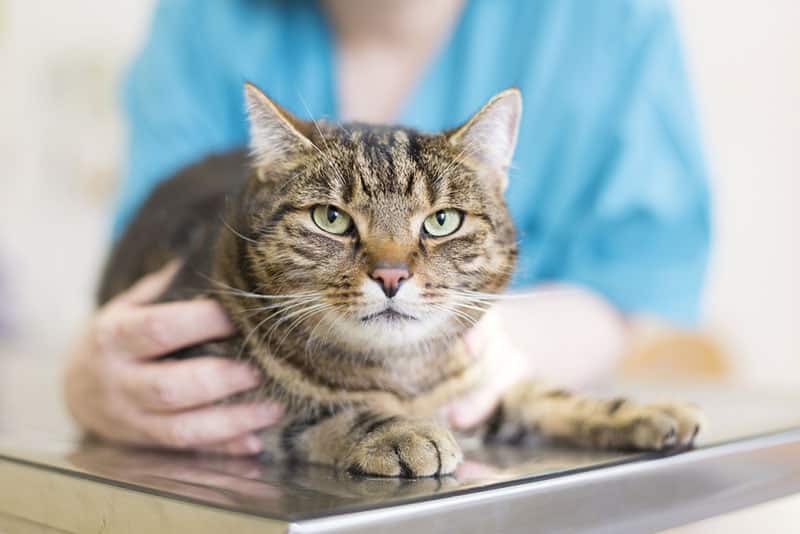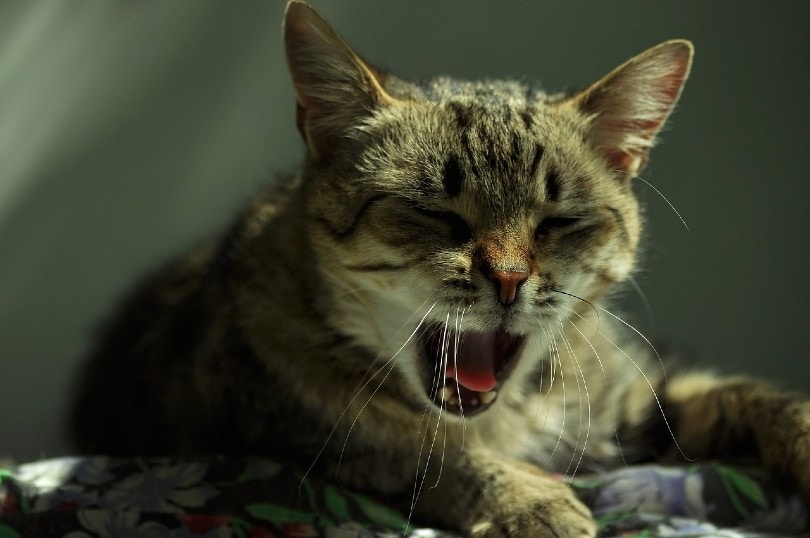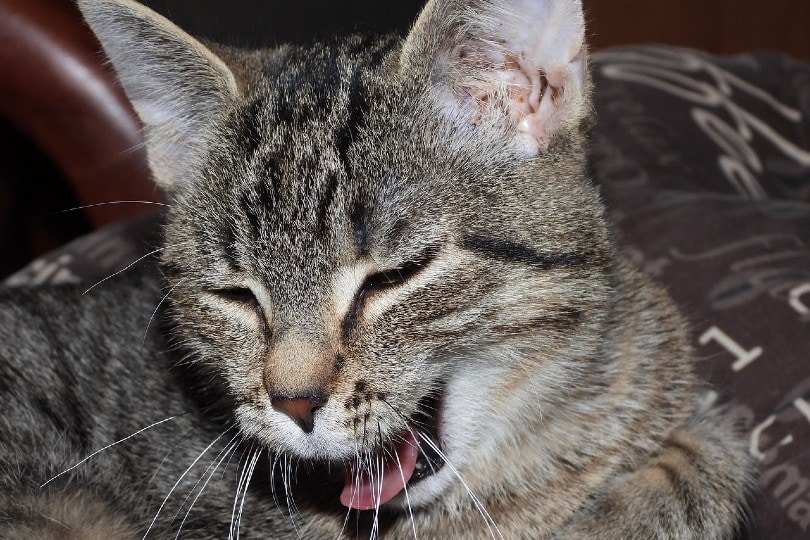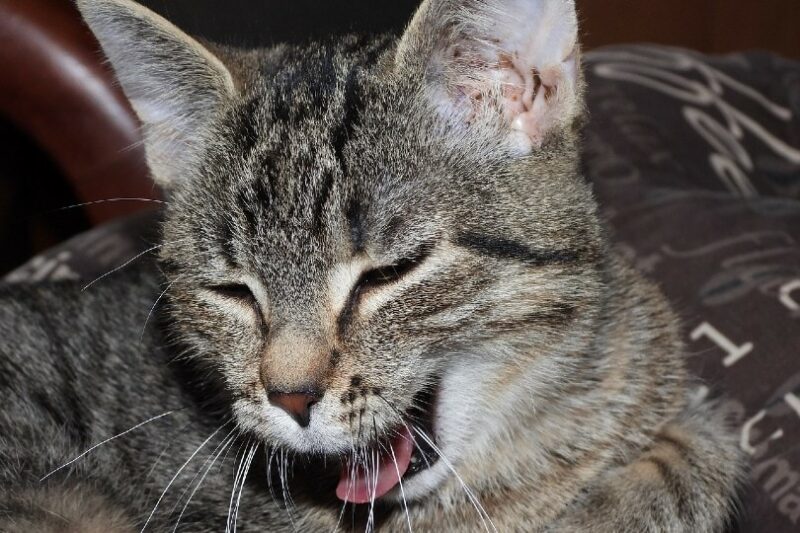True choking occurs when something is stuck at the very back of the throat, which leads to the windpipe being obstructed. This often occurs when the animal doesn’t chew thoroughly or eats something that they shouldn’t. Fortunately, cats are quite good at discerning what they eat and rarely ingest food that is too large or something inedible.
However, that doesn’t mean that choking can’t still occur. In some cases, there may not be time to rush the cat to the vet, but this should always be attempted as urgently and safely as possible. If there is absolutely no time, there are ways to help a choking cat at home, including with a method that is a bit like the Heimlich maneuver. However, it works a bit differently in cats than in people.
All that said, many things can look like choking without actually being choking. It’s important to distinguish between true choking and “fake” choking. You don’t want to treat a cat incorrectly, as the procedure may cause them harm—not only if done incorrectly or for the wrong reasons but also if done correctly in a cat that is genuinely choking. Either way, your cat will need to see a vet urgently.

Determine If the Cat Is Choking
Figuring out if your cat is choking or not can be challenging. Choking can look like several other conditions. However, these conditions often need to be treated differently than choking, so it’s vital that you can distinguish between them (and quickly). Always seek urgent veterinary assistance, no matter what the cause of choking is.
It’s important to understand that choking can happen if there is a foreign object at the back of the throat that has ended up in the windpipe (trachea), blocking the flow of air in and out of the lungs. Cats may also choke if something is wrapped around their neck, such as a ribbon or piece of string.
Choking usually includes the inability to breathe, gagging, drooling, pawing at the mouth, severe distress, and coughing. Cats will not make much noise if their airway is completely blocked and will quickly collapse due to lack of oxygen to the brain and become unresponsive, with their mucus membranes (gum and tongue color) becoming blue.

Cats coughing up fur balls (or just about anything else) may look like they are choking. They are actually trying to vomit up the fur and will exhibit abdominal movements and contractions typical for vomiting, often accompanied by meowing just before bringing it up. This isn’t choking and doesn’t usually require human intervention. (However, if it happens a lot, you will need to see your vet.)
Exaggerated or labored breathing for any reason can look like choking. However, some air is usually moving, and other signs of choking may not be present (such as pawing at the mouth). Your cat may make squeaking or whistling noises, drool, breathe with an open mouth, or have nasal discharge. Any respiratory difficulty is considered an emergency and needs your vet’s attention immediately rather than any home interventions. If left untreated, they can become life threatening very quickly, particularly if a cat is breathing with their mouth open.
You should consider what your cat was doing right before the episode occurred. If the cat was sleeping or quietly walking around, they likely aren’t choking. If the cat was playing with a toy or a piece of their food that cannot be found, they might be choking. Consider if they had access to anything that may be stuck.
If you still have no idea, you can check the color of your cat’s gums. Pink gums indicate that your cat is getting enough oxygen. However, purple or blue gums indicate that your cat isn’t getting enough air. This is usually a clear sign of choking.

Remove the Obstruction
As soon as you’ve noticed that the cat is choking, you should act right away. While you should seek veterinary care during the incident, there is usually not enough time to get to the vet right away. Choking is life threatening and needs to be treated within a few minutes.
*If you’re sure your cat is choking, start here.*
First, secure the cat in a towel or another material. Leave the head exposed. This enables you to help the cat without getting clawed. Get a helper to hold the cat in the towel as gently as possible.
Next, look in the cat’s mouth, and angle the cat’s head slightly back to see down the throat. Hold the upper part of the cat’s muzzle with one hand, and use the other to open the lower jaw. If you can see the object, attempt to remove it (having a helper is extremely helpful here). Ideally, use a pair of tweezers, as putting your fingers in the cat’s mouth isn’t advised, and you may get bitten. Do not push anything inside the mouth; otherwise, you may lodge it farther or cause damage to the soft tissues of the mouth and throat.
If you cannot see the blockage or remove it easily and your cat cannot breathe, do not attempt to get it—skip to the next step. Do not risk pushing the blockage farther if you cannot grip it easily.
Use the palm of your hands to firmly tap your cat on both sides of their chest and between the shoulder blades. This may help them cough the object out. Try it a few times. If that doesn’t work, you’ll need to use squeezing compressions.
These squeezing or abdominal thrust compressions are similar to those of the Heimlich maneuver for people in that they’re intended to help expel the blockage. To do them, sit the cat on the floor facing away from you. Wrap the cat in a towel if one is available, but don’t waste your time if the cat is not responsive. Your cat’s head should be up, their back next to your chest, and their paws are facing away from you. Place a hand and form a fist just below the cat’s rib cage, underneath the sternum or the breast bone. Do not apply so much pressure that you cause injuries and break the cat’s ribs. Use a few jerking upward movements while pushing toward your own belly.
If your cat coughs, it is working. Check their mouth for any dislodged objects that have been causing the obstruction, and try to remove them with a pair of tweezers if they are now more accessible. Squeeze up to five times. If it doesn’t work by the fifth time, it likely isn’t going to work. It would be best to perform this while on the way to your vet, with someone else driving.

Treating an Unconscious Cat
If, for one reason or another, the cat becomes unconscious, treatment needs to be different. In choking situations, this is the result of too little oxygen. While unconscious cats need to be treated right away, they may be a bit easier to treat (as they won’t be fighting you).
First, open the cat’s mouth as wide as possible. Look for the obstruction. If you can see it easily, remove it if possible. Do not put any pressure on the object, as you do not want to push it farther into the airway.
Second, wipe away any fluid and tilt your cat’s head down. You don’t want the fluid to move down into the lungs. You want it to come out of the cat’s mouth. Be careful not to put your fingers in there, as you may still get bitten. If the obstruction cannot be cleared this way, perform the previously described maneuver.
If your cat is not breathing, begin rescue CPR if you know how to do so safely and adequately. To do this, make sure your cat’s mouth is closed with their tongue safely placed inside and breathe through their nostrils, pushing in a breath of air every 4 to 5 seconds, offering three to five breaths. If there is no heartbeat, perform gentle chest compressions too.
Use one hand, placing your thumb on one side of the chest just behind the elbows, where the heart is and your fingers on the other, giving it quick and regular squeezes in order to compress the chest to about one-third of its normal thickness. Do this 100–120 times per minute, if possible, and continue giving artificial breaths if your cat is not breathing. Unfortunately for cats in this situation, the prognosis is often dire and they are unlikely to survive.
Seeking Veterinary Care
Cats have very sensitive throats. During a choking episode, the throat may get damaged or irritated. This may cause it to spasm, which can cause respiratory difficulties. Therefore, you must seek veterinary attention after a choking episode, even if the cat seems fine. The vet can assess the cat and their throat and provide medication to prevent this from happening.
If possible, have a helper call the vet while you’re working on the cat so they can prepare for your arrival.
Your cat may also be oxygen deprived and need supplemental oxygen with intensive hospitalization. Your vet can determine if this is the case and apply supplemental oxygen and other treatments appropriately.

Conclusion
While choking in cats is very rare, it isn’t impossible. This condition is life threatening and can cause death if the airway remains obstructed. Therefore, it needs to be treated right away, ideally at the vet, but this isn’t always possible. There are several ways to do this at home or on the way to the vet if there is no time to waste.
The most straightforward way is to remove the obstruction, but you don’t want to apply too much pressure to the object, as this can make it slide farther into the airway. If removing the obstruction from the mouth or back of the throat isn’t possible using a pair of tweezers, you can try to tap both sides of your cat’s chest or behind their shoulder blades in order to help them cough, or you can attempt the abdominal thrust, which is quite similar to the Heimlich maneuver. This may help expel the obstruction, so check your cat’s mouth afterward for dislodged foreign objects. Seek immediate veterinary help, and consider CPR if your cat is not breathing or does not have a heartbeat.
Featured Image Credit: Ada K, Pixabay










